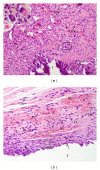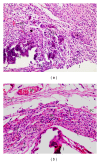Biocompatibility of intracanal medications based on calcium hydroxide
- PMID: 23320187
- PMCID: PMC3535743
- DOI: 10.5402/2012/904963
Biocompatibility of intracanal medications based on calcium hydroxide
Abstract
Objective. The aim of this study was to evaluate the rat subcutaneous tissue reaction to calcium hydroxide-based intracanal medicaments, UltraCal XS (calcium hydroxide, barium sulphate, aqueous matrix), Hydropast (calcium hydroxide, barium sulphate, and propyleneglycol), and Calen (Calcium hydroxide, zinc oxide, colophony, and polyethyleneglycol), used as a control. Methods. Forty-eight rats (Rattus Norvegicus Holtzman) were distributed in three groups: Calen, UltraCal XS, and Hydropast. Polyethylene tubes filled with one of the medicaments were implanted in the dorsal subcutaneous. After 7 and 30 days, the implants were removed and the specimens were fixed and embedded in paraffin. Morphological and quantitative analyses were carried out in the HE-stained sections. The numerical density of inflammatory cells in the capsule was evaluated and statistical analyses were performed (P ≤ 0.05). Results. At 7 days, all materials induced an inflammatory reaction in the subcutaneous tissue adjacent to the implants. In all groups, a significant reduction in the number of inflammatory cells and giant cells was verified in the period of 30 days. Conclusion. These results indicate that the calcium hydroxide-based medicaments evaluated present biocompatibility similar to Calen.
Figures



Similar articles
-
Antibacterial activity, cytocompatibility and effect of Bio-C Temp bioceramic intracanal medicament on osteoblast biology.Int Endod J. 2021 Jul;54(7):1155-1165. doi: 10.1111/iej.13502. Epub 2021 Mar 18. Int Endod J. 2021. PMID: 33638900
-
Effectiveness of calcium hydroxide-based intracanal medicaments against Enterococcus faecalis.Int Endod J. 2012 Apr;45(4):311-6. doi: 10.1111/j.1365-2591.2011.01976.x. Epub 2011 Nov 14. Int Endod J. 2012. PMID: 22077915 Clinical Trial.
-
Subcutaneous tissue response of isogenic mice to calcium hydroxide-based pastes with chlorhexidine.Braz Dent J. 2009;20(2):99-106. doi: 10.1590/s0103-64402009000200002. Braz Dent J. 2009. PMID: 19738940
-
Biocompatibility of an experimental MTA sealer implanted in the rat subcutaneous: quantitative and immunohistochemical evaluation.J Biomed Mater Res B Appl Biomater. 2012 Oct;100(7):1773-81. doi: 10.1002/jbm.b.32744. Epub 2012 Jul 23. J Biomed Mater Res B Appl Biomater. 2012. PMID: 22821748
-
Root canal medicaments.Int Dent J. 2009 Feb;59(1):5-11. Int Dent J. 2009. PMID: 19323305 Review.
Cited by
-
Toxicity of calcium hydroxide nanoparticles on murine fibroblast cell line.Iran Endod J. 2015 Winter;10(1):49-54. Epub 2014 Dec 24. Iran Endod J. 2015. PMID: 25598810 Free PMC article.
-
Cytotoxicity, Biocompatibility, and Calcium Deposition Capacity of 45S5 Bioglass Experimental Paste and Bio-C Temp: In Vitro and In Vivo Study Using Wistar Rats.J Funct Biomater. 2024 Jul 4;15(7):184. doi: 10.3390/jfb15070184. J Funct Biomater. 2024. PMID: 39057305 Free PMC article.
-
Effect of association of non-steroidal anti-inflammatory and antibiotic agents with calcium hydroxide pastes on their cytotoxicity and biocompatibility.Clin Oral Investig. 2020 Feb;24(2):757-763. doi: 10.1007/s00784-019-02923-y. Epub 2019 May 28. Clin Oral Investig. 2020. PMID: 31139978
-
pH influences the biocompatibility of methylene blue solutions.Clin Oral Investig. 2018 Jan;22(1):361-367. doi: 10.1007/s00784-017-2120-4. Epub 2017 May 23. Clin Oral Investig. 2018. PMID: 28536783
-
Bioactive potential of Bio-C Temp demonstrated by systemic mineralization markers and immunoexpression of bone proteins in the rat connective tissue.J Mater Sci Mater Med. 2024 Feb 14;35(1):13. doi: 10.1007/s10856-024-06781-3. J Mater Sci Mater Med. 2024. PMID: 38353838 Free PMC article.
References
-
- Tronstad L. Recent development in endodontic research. Scandinavian Journal of Dental Research. 1992;100(1):52–59. - PubMed
-
- Siqueira JF., Jr. Aetiology of root canal treatment failure: why well-treated teeth can fail. International Endodontic Journal. 2001;34(1):1–10. - PubMed
-
- Faria G, Nelson-Filho P, Freitas AC, Assed S, Ito IY. Antibacterial effect of root canal preparation and calcium hydroxide paste (Calen) intracanal dressing in primary teeth with apical periodontitis. Journal of Applied Oral Science. 2005;13:351–355. - PubMed
-
- Leonardo MR, Hernandez MEFT, Silva LAB, Tanomaru-Filho M. Effect of a calcium hydroxide-based root canal dressing on periapical repair in dogs: a histological study. Oral Surgery, Oral Medicine, Oral Pathology, Oral Radiology and Endodontology. 2006;102(5):680–685. - PubMed
-
- Lima RKP, Guerreiro-Tanomaru JM, Faria-Júnior NB, Tanomaru-Filho M. Effectiveness of calcium hydroxide-based intracanal medicaments against Enterococcus faecalis. International Endodontic Journal. 2012;45(4):311–316. - PubMed
LinkOut - more resources
Full Text Sources

